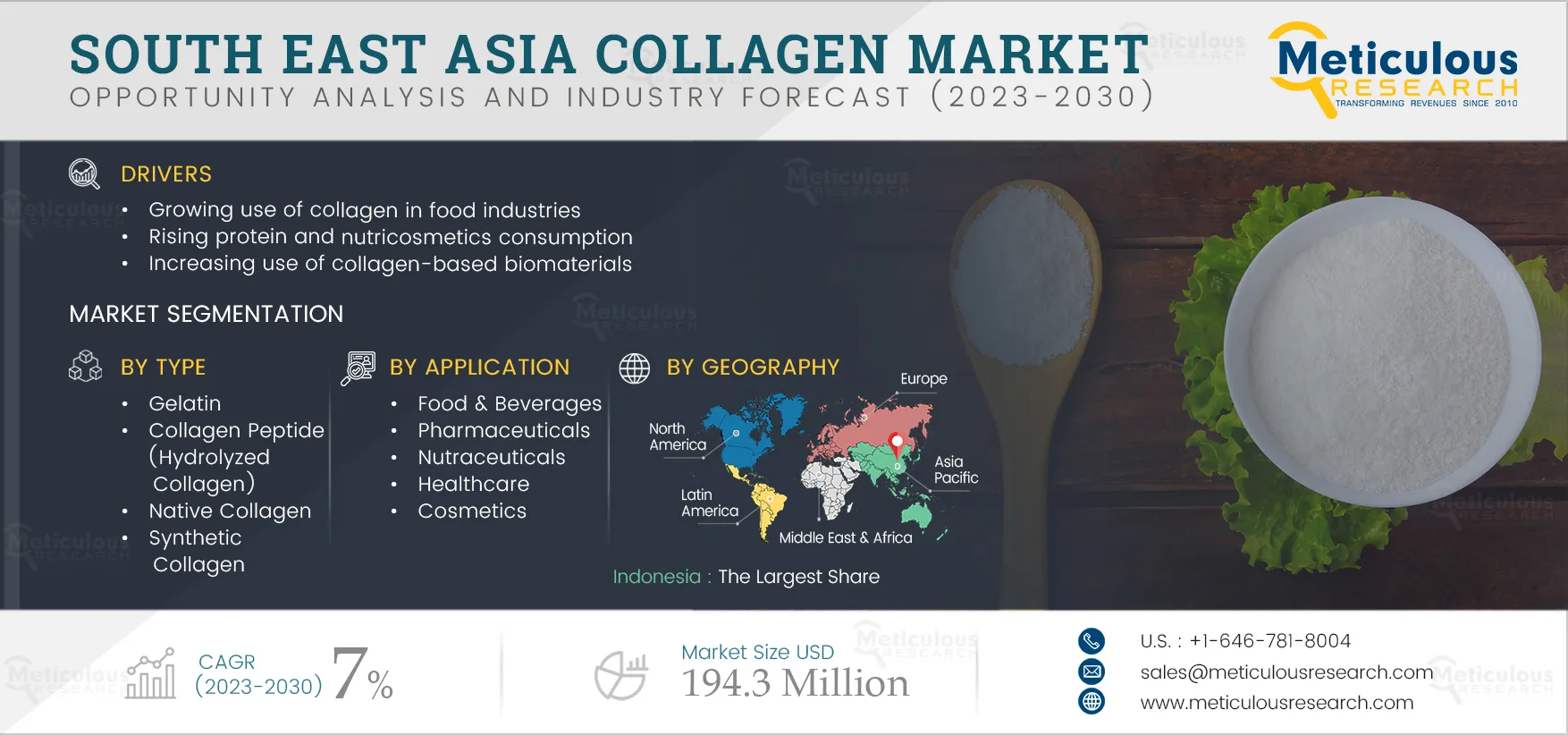Resources
About Us
South East Asia Collagen Market by Type (Gelatin, Collagen Peptide, Native Collagen, Synthetic Collagen), Source (Bovine, Porcine, Fish, Chicken), Application (Food & Beverages, Pharmaceuticals, Nutraceuticals, Healthcare, Cosmetics) - Forecast to 2030
Report ID: MRFB - 104111 Pages: 200 Oct-2023 Formats*: PDF Category: Food and Beverages Delivery: 24 to 48 Hours Download Free Sample ReportThe South East Asia Collagen Market is expected to reach $194.3 million by 2030, at a CAGR of 7% during the forecast period of 2023 to 2030. The growing use of collagen in food industries, rising protein and nutricosmetics consumption, growing application in healthcare, and increasing use of collagen-based biomaterials are the key factors driving the growth of the South East Asia collagen market. Furthermore, the growing food processing industry is expected to offer significant opportunities for the players operating in this market.
Key Players
The report includes a competitive landscape based on an extensive assessment of the key growth strategies adopted by leading market participants in the South East Asia collagen market between 2020 and 2023. The key players profiled in this South East Asia collagen market study are Rousselot (Part of Darling Ingredients Inc.) (Netherlands), GELITA AG (Germany), Weishardt (France), Tessenderlo Group NV (Belgium), Nitta Gelatin Inc. (Japan), ITALGEL S.r.l. (Italy), Holista Colltech Limited (Australia), Collagen Solutions (US) LLC (U.S.), Gelnex (Brazil), Advanced BioMatrix, Inc. (U.S.), Hangzhou Nutrition Biotechnology Co., Ltd. (China), Foodmate Co., Ltd. (China), Trobas Gelatine B.V. (Netherlands), and Jiangxi Cosen Biochemical Co., Ltd. (China).

Click here to: Get Free Sample Pages of this Report
Collagen, with its unique properties, has been extensively used in food processing industries. These properties are usually categorized into two groups. First, the properties associated with its gelling behavior, such as texturizing, thickening, gel formation, and water binding capacity, and second, the properties related to its surface behavior, which include emulsion, foam formation, stabilization, adhesion & cohesion, protective colloid function, and film-forming capacity. Apart from these properties, collagen is also considered a good surface-active agent and demonstrates its ability to penetrate a lipid-free interface.
Collagen finds its major application in food industries like dietary supplements, functional foods, beverages, confectionery, and desserts. It has been widely used as a food additive that improves the organoleptic properties of food products. For instance, the use of collagen in sausages and frankfurters improves its rheological properties and also the presence of animal nutritive fibers in adequate amounts. Also, foods like desserts, trifles, aspic, marshmallows, candy corn, and confections such as peeps, gummy bears, fruit snacks, and jelly babies contain large amounts of gelatin.
Demand for collagen is expected to increase in the near future in the food industry, offering many opportunities to stakeholders in this market due to the fact that over the last decade, there has been a significant rise in demand for processed food and consumption of bakery & confectionary products. This rising demand for processed food is attributed to the increased per capita income across South East Asia, increasing population, and changing lifestyles.
Increasing Use of Collagen-based Biomaterials to Drive the Growth of the South East Asia Collagen Market
Biomaterial science is an expanding area that encompasses a wide range of medical knowledge involving arthroplasty, lenses, dental fixation, and tissue engineering. In vitro cell culture on polymer scaffolds is one of the adopted strategies for tissue creation. It provides biocompatibility, controllable biodegradability, and the ability to absorb body fluids for the delivery of nutrients. Collagen certainly fulfills these demands; therefore, it is often chosen as a biomaterial.
Collagen-based biomaterials are used extensively for various applications. For instance, collagen films are used in the treatment of tissue infection as a barrier membrane, collagen shields are designed for contact lenses, collagen gels are primarily used for injectable systems, and collagen pellets/tablets are used as gene delivery carriers. In addition, collagen is also used in dentistry due to its ability to enhance wound healing following dental therapy by clot formation.
Therefore, collagen has various advantages as a biomaterial and is widely used as a carrier system for the delivery of drugs, proteins, and gene. The usefulness of human skin substitutes made of collagen has led to the development of bioengineering tissues. Thus, collagen-based biomaterials are expected to become a useful matrix substance for various biomedical applications in the future.
In 2023, the Gelatin Segment to Dominate the South East Asia Collagen Market
Based on type, in 2023, the gelatin segment is expected to account for the largest share of the South East Asia collagen market. The large market share of this segment is attributed to the increased demand from the food and pharmaceutical industries due to its outstanding stabilizing features and binding characteristics. Nutritional gummies, chewable soft capsules, and enteric capsules are the recent trends in pharma drug deliveries where a mass volume of gelatin is being used. In addition, the growing usage of gelatin in photography, nutraceuticals, and cosmeceuticals is also contributing to its large adoption. Moreover, this segment is expected to register the highest CAGR due to the rising fish industry in South East Asia.
The Fish Collagen Segment to Witness Highest Demand During the Forecast Period
Based on source, in 2023, the bovine collagen segment is expected to account for the largest share of the South East Asia collagen market. The large market share of this segment is attributed to its several health benefits, such as skin health, tendon reinforcement, bone loss prevention, and relief from arthritis. This makes bovine collagen one of the widely used and accepted forms of collagen.
However, the fish collagen segment is projected to witness significant growth during the forecast period of 2023–2030. The rapid growth of this segment is mainly driven by the increasing pisciculture practices, growing consumer inclination towards a healthy lifestyle and high protein consumption, rising number of people experiencing joint discomfort, and its ability to improve skin comfort, nourish the epidermis, and increase skin elasticity.
In 2023, the Food & Beverages Segment to Dominate the South East Asia Collagen Market
Based on application, in 2023, the food & and beverages segment is expected to account for the largest share of the South East Asia collagen market. The large market share of this segment is attributed to vast applications of collagen across the food & beverages industry due to its unique gelling and surface behavior properties. It also improves the texture and mouthfeel of food products. It is used to add a smooth, creamy texture to dairy products, soups, and sauces. In meat products, it helps to retain moisture and improve tenderness. This is expected to boost the demand for collagen in food & beverages.
In 2023, Indonesia is Expected to Dominate the South East Asia Collagen Market
Based on country, the South East Asia collagen market is segmented into Indonesia, Thailand, Malaysia, Philippines, Vietnam, Singapore, and the Rest of South East Asia. In 2023, Indonesia is expected to account for the largest share of the South East Asia collagen market. The large share of this market is mainly attributed to its booming food & beverages sector due to various factors such as growing population, increased urbanization, growing awareness of healthy products, rising incomes, the shift of consumers towards modern retail stores, and the growing tourism industry. Additionally, the rising demand for cosmetics and personal care products and the growing livestock and meat processing industry further drive the growth of the collagen market in the country.
Scope of the Report:
South East Asia Collagen Market Assessment, by Type
South East Asia Collagen Market Assessment, by Source
South East Asia Collagen Market Assessment, by Application
South East Asia Collagen Market Assessment, by Country
Key Questions Answered in the Report:
This report covers the market sizes & forecasts of the South East Asia collagen market based on type, source, application, and country. This report also provides the value & volume analysis of various segments and subsegments of the South East Asia collagen market at country levels.
The South East Asia collagen market is projected to reach $194.3 million by 2030, growing at a CAGR of 7% during the forecast period.
Based on type, in 2023, the gelatin segment is expected to account for the largest share of the South East Asia collagen market.
Among all mode of application segments studied in this report, the nutraceuticals segment is projected to witness significant growth during the forecast period of 2023–2030. The rapid growth of this segment is mainly driven by the growing use of nutraceuticals for weight management across South East Asia and increasing consumer awareness regarding the consumption of supplements for preventive care.
The growth of this market is driven by the growing use of collagen in food industries, rising protein and nutricosmetics consumption, growing application in healthcare, and increasing use of collagen-based biomaterials. Furthermore, the growing food processing industry is expected to provide significant growth opportunities for players operating in this market.
The key players operating in the South East Asia collagen market are Rousselot (Part of Darling Ingredients Inc.) (Netherlands), GELITA AG (Germany), Weishardt (France), Tessenderlo Group NV (Belgium), Nitta Gelatin Inc. (Japan), ITALGEL S.r.l. (Italy), Holista Colltech Limited (Australia), Collagen Solutions (US) LLC (U.S.), Gelnex (Brazil), Advanced BioMatrix, Inc. (U.S.), Hangzhou Nutrition Biotechnology Co., Ltd. (China), Foodmate Co., Ltd. (China), Trobas Gelatine B.V. (Netherlands), and Jiangxi Cosen Biochemical Co., Ltd. (China).
Malaysia and Singapore recorded the highest CAGR during the forecast period. The growth of this market is mainly driven by the growing awareness among consumers regarding life-threatening diseases and conditions due to the lack of nutrients and the rising trend towards improving skin health by reducing dryness and wrinkles, increasing muscle mass, and using collagen as a nutricosmetic ingredient.

























Published Date: Jul-2024
Please enter your corporate email id here to view sample report.
Subscribe to get the latest industry updates